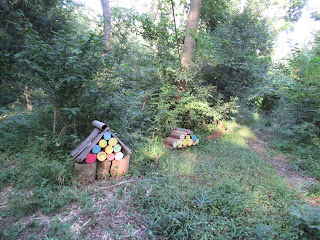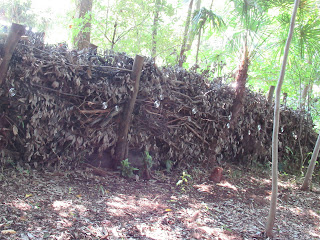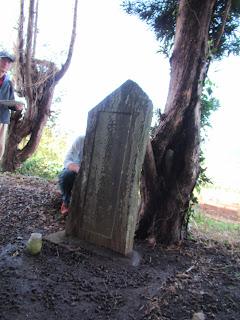In Japan, it is said that no heat or cold lasts over the equinox … Oh yeah? At least the last week of September 2023 in Yokohama is recording maximum temperature above 30°C. Boiling planet … Anyway, in Japan autumn and spring equinoxes are for visiting graveyard of family, hoping for ancestral sprits resting in peace and approaching paradise. We call a week whose midday is equinox Ohigan お彼岸. The word is from Chinese translation of Sanskrit whose meaning is “the Other side.” This Side is where we live with earthly desires. The Other Side is for somebody who graduated from such stupid wishes and enters Nirvana. We celebrate Ohigan visiting graveyard, and wishing good luck for those in the tomb reaching “the Other Side” of eternal happiness … And there is flower it opens just in time for the festival. It’s Red Spider Lilies (Lycoris radiata).
 |
| At the
entrance of Niiharu Citizen Forest around the Autumn Equinox 2022. |
 |
| Spider
Lilies first sprout their buds, not leaves. They next flower, and finally the leaves come out. In late autumn, the plant becomes like this. Not flashy any more … |
In Japanese Red Spider Lilies are called Higan-bana ヒガンバナ, a flower for Ohigan, or Manjushage 曼珠沙華, Japanese pronunciation of Sanskrit Manjusaka. Manjusaka means “a flower in heaven.” Right. It’s apt. Actually, Higan-bana is not Japanese native, but probably some 2300 years ago came from the continent with technology of rice cultivation. Japanese Red Spider Lilies are triploidy with set of chromosome 3 times more than the standard. They cannot produce seeds. Still, around autumn equinox, we meet this mystical beauty here and there in country sides. Scholars are guessing they were brought in rhizome from Korean Peninsula, or China, by immigrants. Red Spider Lily as a whole is poisonous for direct consumption, but its potato becomes edible starch after removing alkaloid by patient washing with water. Those ancient immigrants could bring them with rice, plant the rhizome around rice paddies. Mouse or rabbits do not wash potato to eat = the plant can stop these eaters entering rice field. Nice strategy to protect harvest. Roots of spider lilies then become emergency food if a famine comes. Clever move from the continent. So, seedless spider lilies can be found near human settlements, or former villages where artificial planting was possible. Maybe its connotation with seasonal festival, very human activity, is inevitable.
 |
| Near
Niiharu Citizen Forest, there is a spot where we can find White Spider Lilies, Lycoris albiflora. It’s a gardening variety created by cross bleeding Red Spider Lilies and yellow Lycoris traubii. It’s popular especially in Kyushu Island, and there were several brides marrying in the families of Niiharu from Kyushu region. They could come together with these lonely ladies from afar ... |
In the early morning of a day after equinox, I’ve been to Niiharu Citizen Forest 新治市民の森, and found many “buds” of Manjushage. I thought they were a bit late, probably due to this Boiling Planet summer … Then, 7 hours later, on my way home, I found the line of Red Spider Lilies fully open. Wow. They bloom this way! Hey, Lilies, autumn is coming, isn’t it?
And today, the max temperature in Yokohama is again over 30°C. Please stop boiling …
 |
| In the early morning, they were like this. |
 |
| Look like asparagus … |
 |
| Then, around 14:00, ta-dah! |
If you find environmental issues in Kanagawa Prefecture, please make a contact with Kanagawa Natural Environment Conservation Center 神奈川県自然環境保全センター
657 Nanasawa, Atsugi City, 243-0121
〒243-0121 厚木市七沢657
Phone: 046-248-0323
You can send an enquiry to them by clicking the bottom line of their homepage at http://www.pref.kanagawa.jp/div/1644/




























































